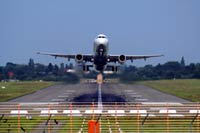Travel Planning |
More planning resources> |
Free time to take an extended road trip is a precious commodity, and as fuel prices continue to inch upward, the "fly-and-drive" road trip makes more and more sense. Whenever possible I love to mosey on road trips, but these days, it seems that I am always on a deadline and need to get back to the office as soon as possible. Taking advantage of air trips to hub cities enables me to grab some "found time" for taking road trips. In the past year, Megan and I have flown to several different regions of the country and enjoyed short road trips to many local scenic attractions. A wedding in Canada gave us the opportunity to tour Glacier National Park in Montana, and a business trip to Atlanta offered a nice chance to drive though the Great Smoky Mountains in Georgia and Tennessee. Other plane trips have allowed a journey down the California coast, a loop around Seattle and a scenic drive in south-central Texas. Here are some tips for setting up your own fly-and-drive road adventure. PRE-TRIP PLANNING 1. Pack a Fly-and-Drive Go-Kit. Most roadtrippers keep a well-stocked "Go-Kit" in their personal roadtripping vehicles, but it's impossible to cram all that gear into a suitcase small enough to fit within airline size and weight limits. The following items are worth the space they consume:
2. Consider luggage forwarding. "Pack heavy, travel light" is the apt slogan of Luggagefree, a luggage-forwarding company based in New York City. Many families, professional athletes, college students and other big-baggaged travelers use its services for transporting strollers, bicycles, golf clubs, skis or any other heavy luggage that they don't want to have to lug through airports. The company offers door-to-door transport and could easily be used to send gear directly to a roadtripper's kickoff motel or hotel. While I haven't tried this service yet, I plan to. I'd love to be able to travel with my tools, safety triangle, CB radio and antenna, portable GPS unit, emergency rations and other key components of the Go-Kit that I keep in my own vehicle. 3. Choose your rental vehicle carefully. Think about what kind of vehicle would make the most sense for your roadtrip. Do you need four-wheel drive? Seating for six? How about GPS navigational equipment or a satellite radio? Generally, we don't rent either of these electronic devices, but they might well be worth the expense to you, and they are often available. Now take a look at your arrival airport. Does its car rental fleet have the type of vehicle you want? If not, you may need to change your airport or make special arrangements with your car rental company to delivery a special-order vehicle to the lot. 4. Make your hotel and motel reservations. Whenever possible, we like to travel without the constraints of motel reservations, but sometimes they make good sense. For fly-and-drive roadtrips, it's helpful to reserve that first night and maybe the last night fairly close to the airport, so you don't have to worry about looking for a room on arrival and the night before you have to catch a plane. Arrange for an early check-in or late check-out if you need it - and you might if you're planning a long drive or have the time and inclination for a mosey road trip. Besides, you'll need time to repack your suitcases for the flight home. Next: ARRIVAL AND ON-THE-ROAD TRAVEL>
|

